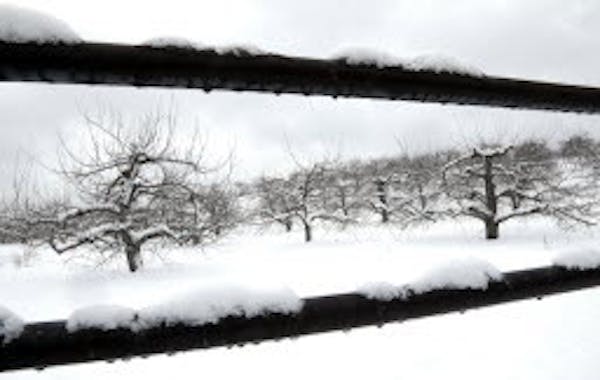Several inches of snow were piling up Wednesday night in many locations around the southern Twin Cities, while many spots north saw nothing.
The National Weather Service says an estimated 12 inches of snow fell on Savage by early evening Wednesday, before it began to taper off in the south metro. That total stood up at 11:56 p.m., when the National Weather Service updated the storm's totals.
Other reports include 11.5 inches of snow in Burnsville, 11 inches 2 miles south of Lakeville and 10 inc inches in several locations.
By contrast, as of 7 p.m., 3.7 inches was recorded at the airport, with 3.2 inches at the Weather Service's office in Chanhassen.
In downtown Minneapolis, snow was swirling through the taller buildings late in the afternoon but failing to coat the streets and sidewalks below thanks to temperatures holding above freezing. It stopped downtown in the early evening, and the northern suburbs largely escaped the early spring reminder of Minnesota's reputation.
By the time this snowstorm is over, up to 14 inches is possible in an area stretching from New Ulm to the southern Twin Cities to Bloomer, Wis.
Overnight, the Weather Service said, the snow was to intensify, with rates of an inch or more an hour possible overnight in south-central Minnesota through Eau Claire, Wis. A winter storm warning was in effect for that area until Thursday morning (7 a.m. in some areas, 9 a.m. in others).
During Wednesday night's commute, travel on metro highways was hampered by the slick conditions and a rash of crashes mainly in the southern suburbs.
Across Minnesota from 10 a.m. to 8 p.m. Wednesday, 171 crashes were reported, 27 of them with injuries, along with 164 vehicles that spinned out or went off the road. The call load was tapering Wednesday night, State Patrol spokeswoman Lt. Tiffani Nielson said.
Still officials were urging people to be cautious. The Weather Service warned Wednesday night that in south-central Minnesota a strong wind was expected to cause near-blizzard conditions along the Interstate 90 corridor. "Travel may become very difficult or impossible" in southern Minnesota.
"Winter is not giving up yet," meteorologist Lisa Schmit said. "This is nothing record setting, but it's one people should take note of."
The Minnesota Department of Transportation had its 102 snowplows at the ready in the 11-county southeastern Minnesota district.
Earlier Wednesday, Sue Mulvihill, MnDOT deputy commissioner and chief engineer, said, "Our plows will be out, hard at work. We need the traveling public to cooperate and help us by slowing down and giving the plows room to work."
The State Patrol advised motorists to stay off the roads in south-central Minnesota was combining to create visibility of near zero at times. A no-travel advisory was in effect Wednesday afternoon in Blue Earth, Brown, Cottonwood, Faribault, Jackson, Martin, Nobles, Rock, Watonwan, Waseca counties, the patrol said.
After a warm March and Tuesday's highs in the upper 50s in the metro and southern Minnesota, the winter wallop might be a bit hard to stomach. The good news is that it's March and the snow won't last long, Schmit said.
"March typically delivers some of our biggest snowfalls," Schmit said. "This looks to be the last one for the season."
But a few flakes could fall on Friday into Saturday, she said.
More springlike conditions will return Sunday with highs in the 40s and touching 50 by Monday, she said.
Still, a spring snowstorm could create weather whiplash for trees and plants.
The unseasonably warm weather in recent weeks had some trees and plants emerging early from their hiatus — weeks earlier than normal, said Kathy Zuzek, an educator in horticulture at the University of Minnesota Extension.
"I've been traveling around the state and I'm seeing silver maples, the aspen and their relatives blooming already," Zuzek said. "The flowers are just about done on the maples. It's very early."
If a snowstorm damages those flowers, those trees aren't likely to seed, she said. Tightly budded trees will be more insulated, and those that haven't leafed out should weather the storm just fine.
For those trees that began to green, a backup plan will compensate for the March storm, Zuzek said. "There are other buds that will take over, and they'll send out a whole new shoot and whole new set of leaves," she said. "You won't end up with bare plants. It will just force them to start all over."
"It's just been a weird winter," Zuzek said. "We had all that warmth in November and December. You could see lilac buds that wanted to push and expand. And we've had a very early spring."
Gardeners could throw a blanket on emerging plants to protect them, Zuzek said. "But there's not a lot you can do," she said. "So no need to freak out."
Minnesota's apple crop also should fare well through a March storm, said John Jacobson, production manager for Pine Tree Apple Orchard in White Bear Lake. Although the apple trees have been coming out of winter dormancy this year earlier than usual, they're not too far ahead that the cold and snow will damage them, he said.
"They're just starting to wake up, but by no means are they fully awake yet," Jacobson said. "The weather is changing to be a little more seasonable, so they'll just take a little more of a nap here and we'll be fine."
This report includes material from the Associated Press.
pwalsh@startribune.com • 612-673- 4482 tim.harlow@startribune.com • 612-673-7768
Robbinsdale shelter-in-place alert accidentally sent countywide
Developer of St. Paul's Keg & Case food hall declares bankruptcy

Wildlife agency: Sturgeon won't go on endangered species list

Minnesotans interviewed to serve on Feeding Our Future trial

